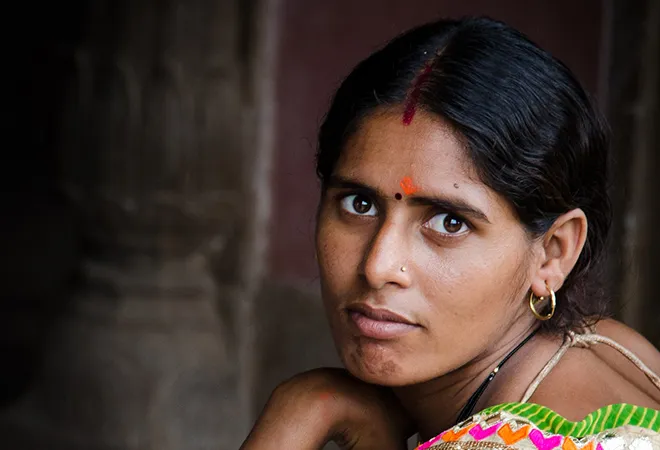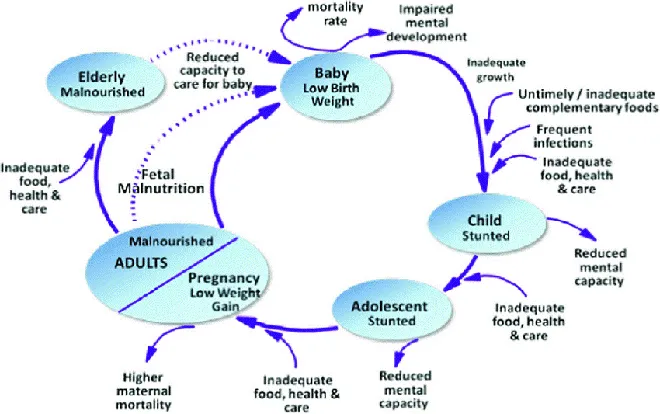 This article is part of the series — Catalysing Change: Women-led Development in the Decade of Action.
This article is part of the series — Catalysing Change: Women-led Development in the Decade of Action.
Adequte nutrition is critical for women’s health and the health of their children. Children born to malnourished mothers are likely to be stunted with reduced mental capacity, develop cognitive impairments, have lower resistance to infections, and have a higher risk of morbidity and mortality throughout their lives (see Figure 1).
Figure 1: Poor Nutrition throughout the Lifecycle
 Source: UNSCN.org
Source: UNSCN.org
Indian women — with a quarter women being thin (with body mass index less than 18.5 kg/m) — have a greater chance of giving birth to low birth-weight babies that more prone to infections and growth failure, perpetuating an intergenerational cycle of malnutrition. Inadequate nutrition before conception and during the first trimester of pregnancy is largely the cause of foetal stunting. Recent data indicates alarming trends for malnutrition and the looming threat of double burden of malnutrition. Investing in maternal and child health yields a high cost to benefit ratio, with a triple dividend in both low and upper-middle income countries. Early investments in health, education, and development of children reaps benefits throughout the lifecycle.
Investing in maternal and child health yields a high cost to benefit ratio, with a triple dividend in both low and upper-middle income countries.
The Government of India has taken significant measures to combat malnutrition over the past decades through the Integrated Child Development Services (ICDS) Anganwadi system — to provide supplementary nutrition and take home rations to pregnant and lactating women, mid-day meals at school, maternity benefit programmes, and grains at subsidised rates through the public distribution system. The National Food Security Act 2013 ensures that access to food is a legal right by providing food and nutrition security to the vulnerable. India’s flagship programme ‘POSHAN Abhiyaan’ launched on the International Women’s Day in 2018, aims to improve nutritional outcomes for children, pregnant women, and lactating mothers.
Despite all the efforts and programmes, women’s health and education have often been neglected. There is an intersection of low education, poverty, and malnutrition amongst women. According to the World Bank, educating girls and ending child marriage is central to eradicate poverty. The UN’s sustainable development goals calls for gender equality and a quality education by 2030 as education enables socioeconomic mobility; therefore, it is key to escape poverty.
The pandemic will lead to pushing 96 million more people into extreme poverty, with 47 million being women and girls.
With women constituting almost half of India’s population at 48 percent and contributing 18 percent to GDP, a lot needs to be done to address the challenges faced by women. The COVID-19 crisis has led to women bearing the double brunt of economic and social fallout. The pandemic will lead to pushing 96 million more people into extreme poverty, with 47 million being women and girls. This calls for effective implementation of programmes and allocation of budget.
The Union Budget 2021 is disheartening; with reduced allocations for crucial social security programmes for women and children despite the challenges faced by women due to the pandemic. An analysis of the distribution of the budget to women-related programmes shows a either a maintenance of the current status quo or major decline. The budget of the Ministry of Women and Child Development has reduced by 0.7 percent. This budget saw the launch of Mission POSHAN 2.0 to stregthen nutritional content, delivery, and outcome; however, the budget allocation for the POSHAN scheme shows a steep decline of 27 percent (from INR 3,700 to INR 2,700 crore) this time.
The Union Budget 2021 is disheartening; with reduced allocations for crucial social security programmes for women and children.
The schemes have been categorised into SAKSHAM and SAMARTHYA by clubbing some of the schemes under a common umbrella. The flagship programme, POSHAN 2.0, was announced despite the poor implementation of the POSHAN Abhiyaan. SAKSHAM Anganwadi and POSHAN 2.0 brings together under one umbrella the ICDS, POSHAN Abhiyaan, Scheme for Adolescent girls, and National Creche Scheme with an allocation of INR 20,105 crores of the total allocated INR 24,435 crores. This budget indicates the lowest share in the last decade for children at 2.46 percent. The SAMARTHYA clubs together the Pradhan Mantri Matru Vandana Yojana (PMMVY), Beti Bachao Beti Padhao, and empowering rural women scheme. Looking at the gender budget (Table 1 & 2) trends are underwhelming.
Table 1: Saksham Anganwadi and POSHAN 2.0 Budget Allocation

Table 2: SAMARTHYA Budget Allocation
 Source: Statement of Budget estimates
Source: Statement of Budget estimates
The schemes under the SAMARTHYA have not been given their due in this budget, and it is alarming to see a drastic slash in the maternity entitlement scheme. The estimates have been revised by 48 percent leaving out half of the women beneficiaries. The total allocation for the clubbed SAMARTHYA is similar to the PMMVY allocation for last year. It clearly is insufficient to cater to all eligible beneficiaries as the act only covers the ‘first birth.’ This shows poor implementation of the scheme leading to a decline in beneficiaries availing it. The budget allocations seem to neglect adolescent nutrition even as the data indicates high micronutrient deficiencies and poor nutritional status. Schemes for adolescent girls that address their health and nutrition calls for higher allocation and stregthened implementation to improve the declining coverage.
The total allocation for the clubbed SAMARTHYA is similar to the PMMVY allocation for last year. It clearly is insufficient to cater to all eligible beneficiaries as the act only covers the ‘first birth.’
Another drastic decline (from INR 726 to 48 crores) has been seen in the Mission for Protection and Empowerment of Women that facilitates convergence of schemes/programmes of different Ministries/Departments with focus on women. This indicates the sheer neglect of vulnerable women and girls as against the expectation of hope and transformative opportunity.
According to experts “The Budget announced POSHAN Mission 2.0 would be effective only if feeding and not mere provision gets the budget share.” Budget 2021 seems to be nothing more than lip service to women’s health and nutrition. There is an urgent need to invest in women and children’s health for sustainable development along with saving lives and improving quality of life.
It is rightly said, “Women’s health needs to be front and center — it often isn’t, but it needs to be.”
The views expressed above belong to the author(s). ORF research and analyses now available on Telegram! Click here to access our curated content — blogs, longforms and interviews.



 This article is part of the series —
This article is part of the series —  Source: UNSCN.org
Source: UNSCN.org
 Source:
Source:  PREV
PREV


